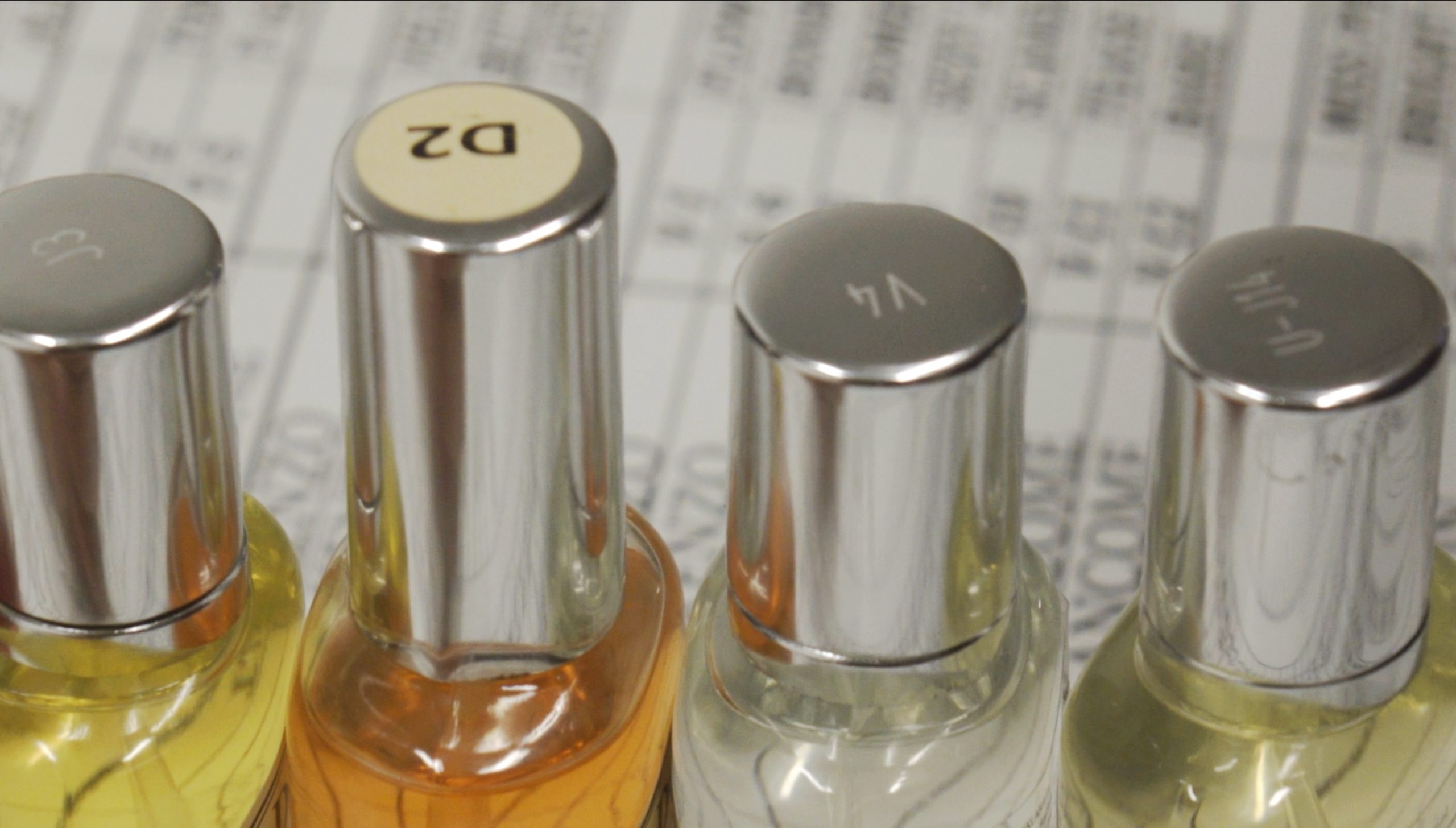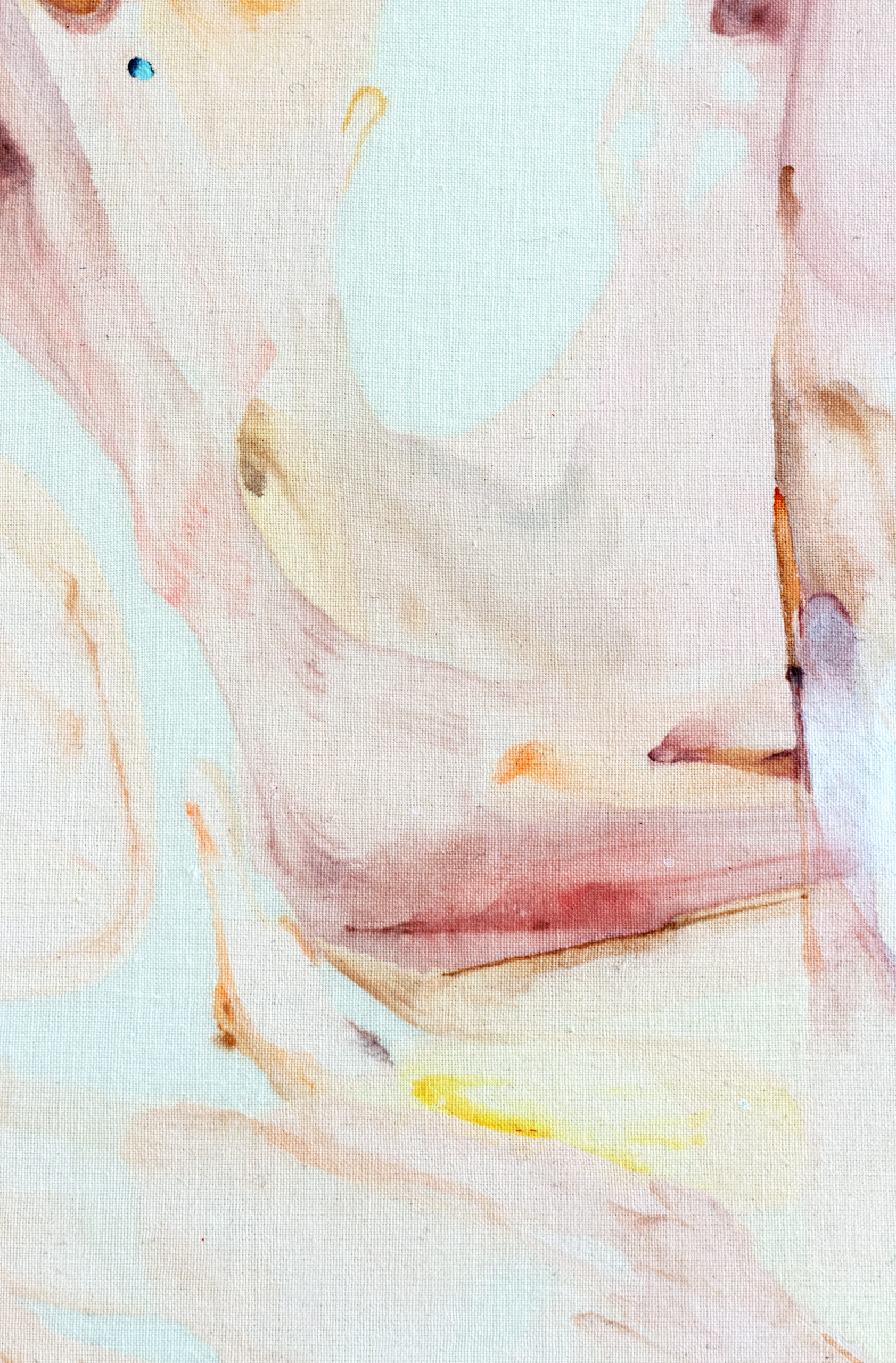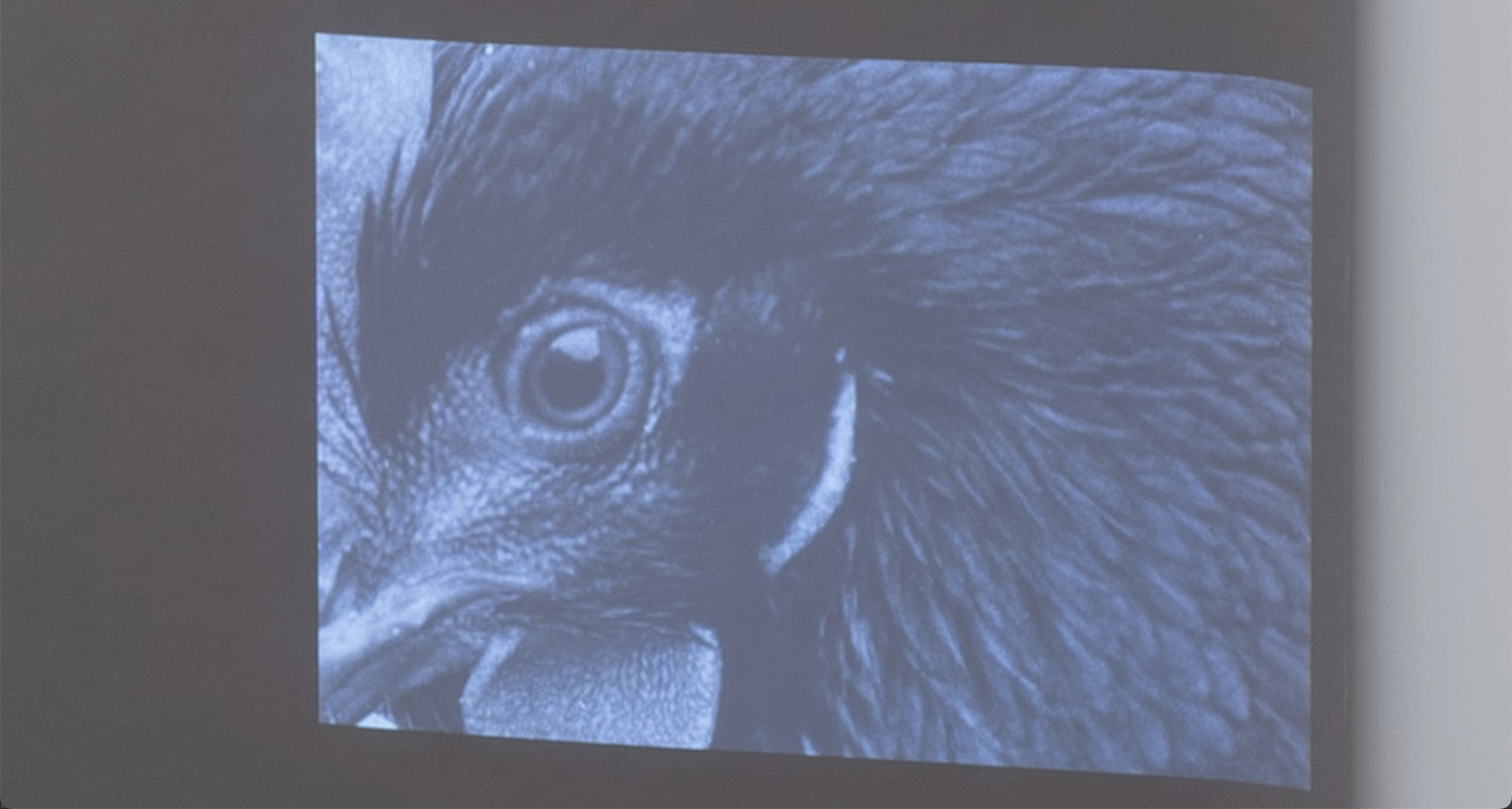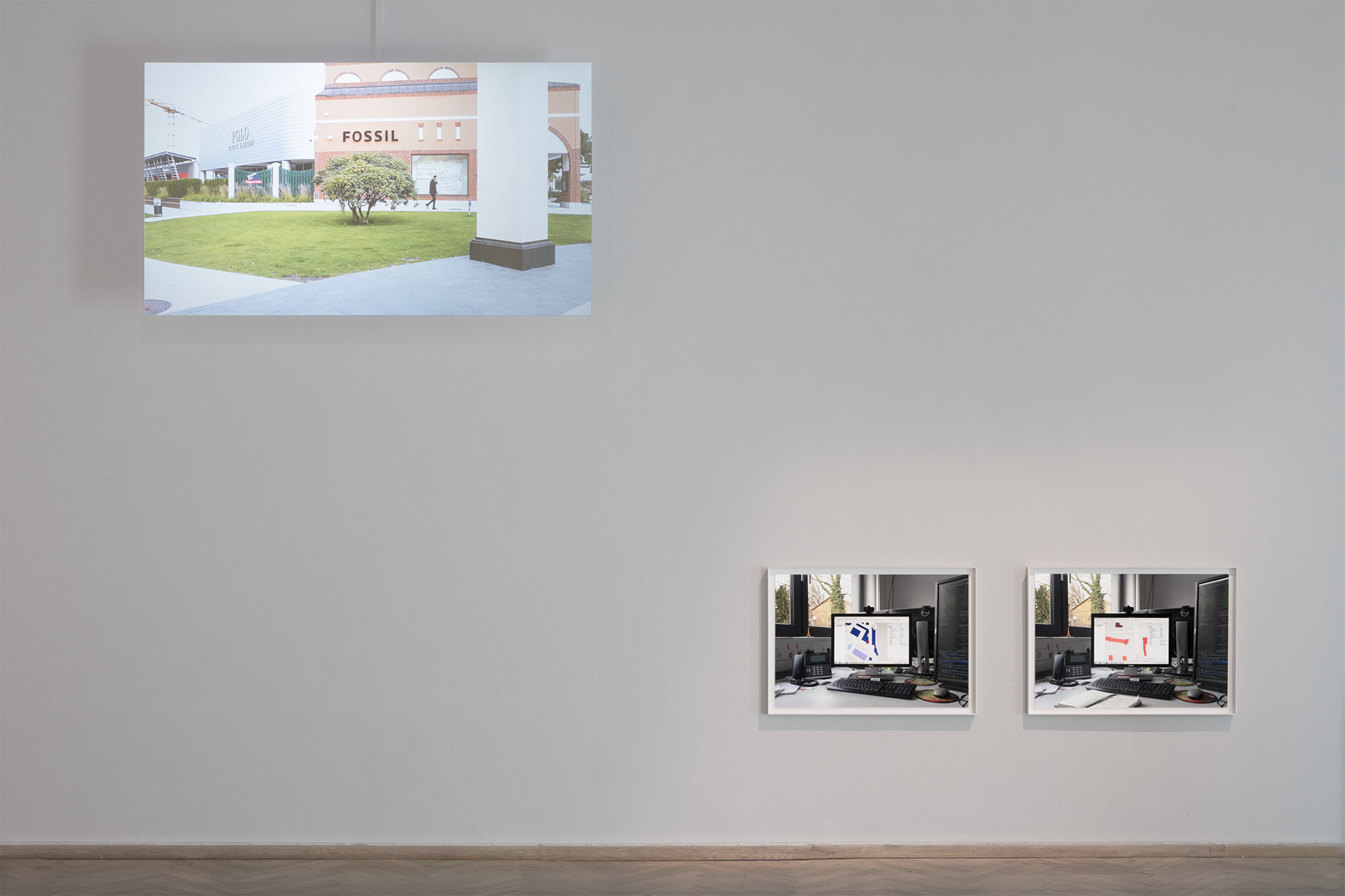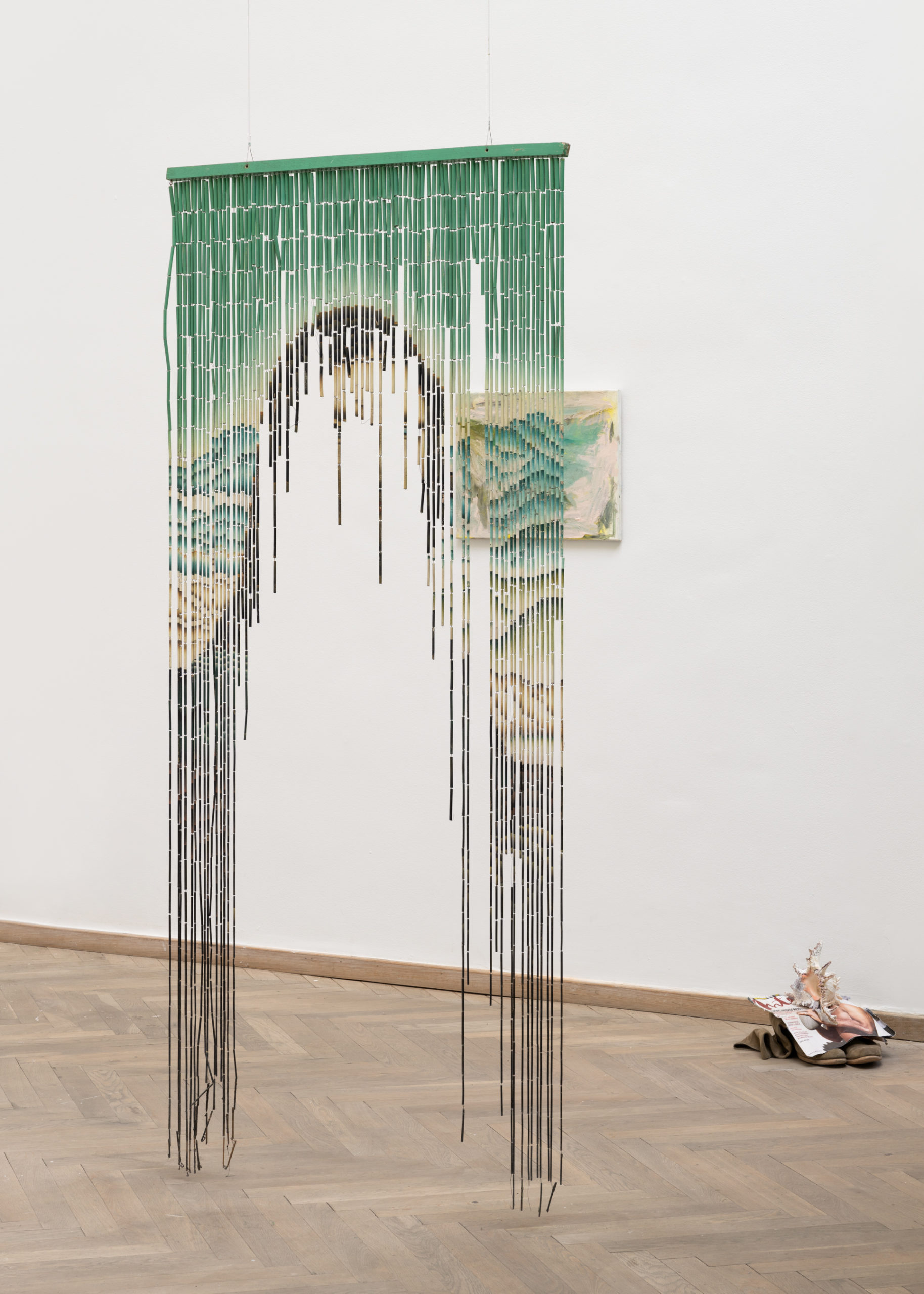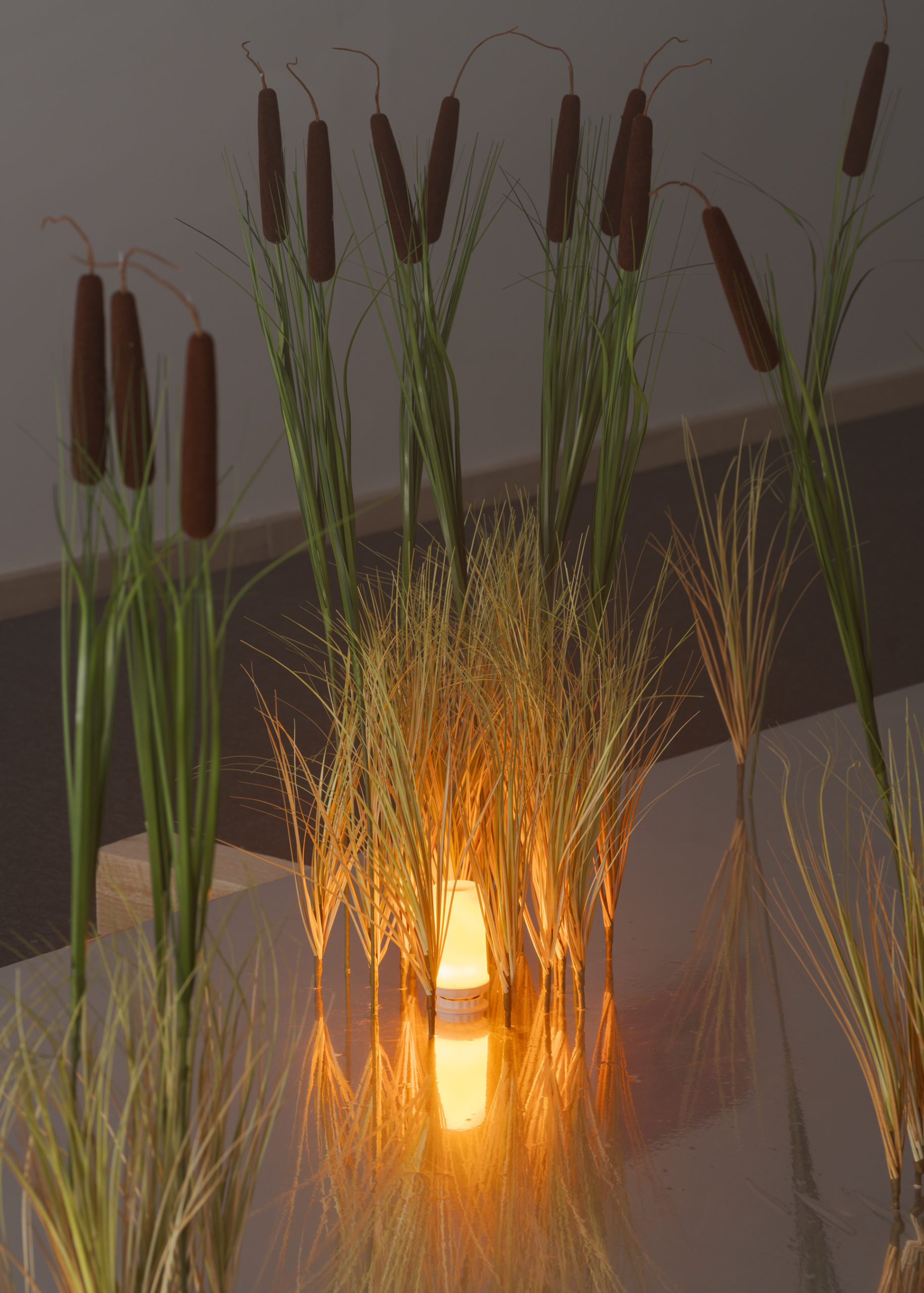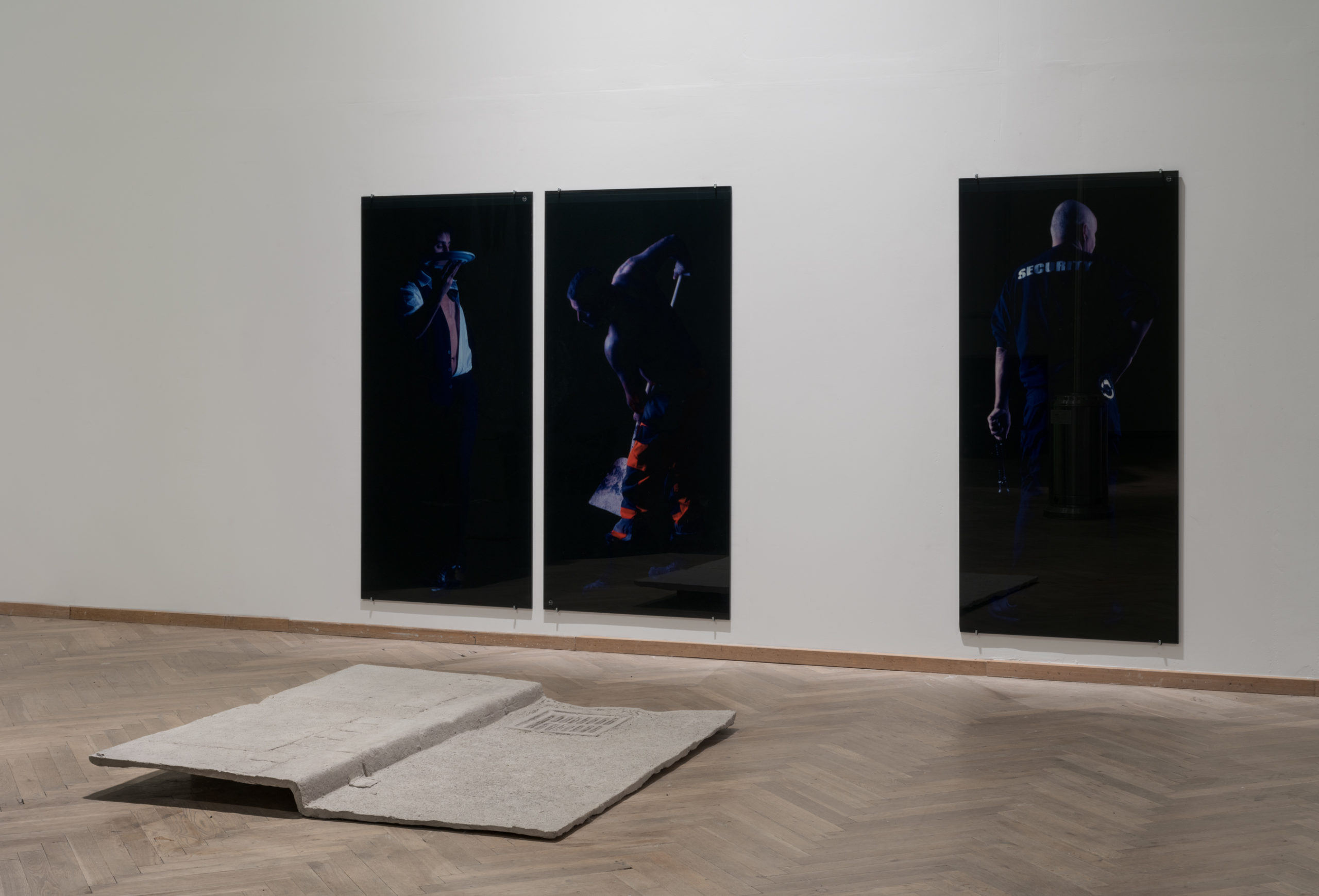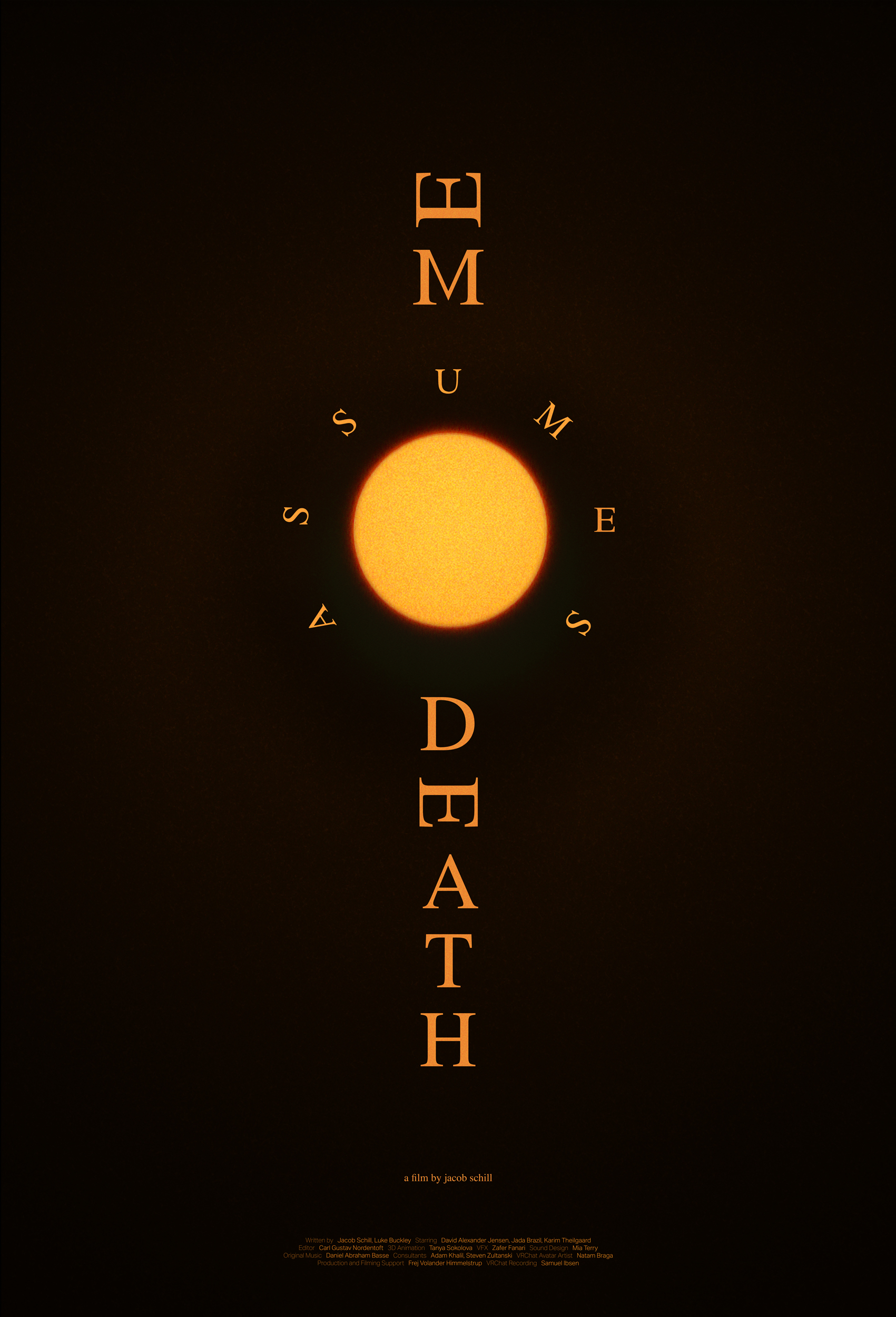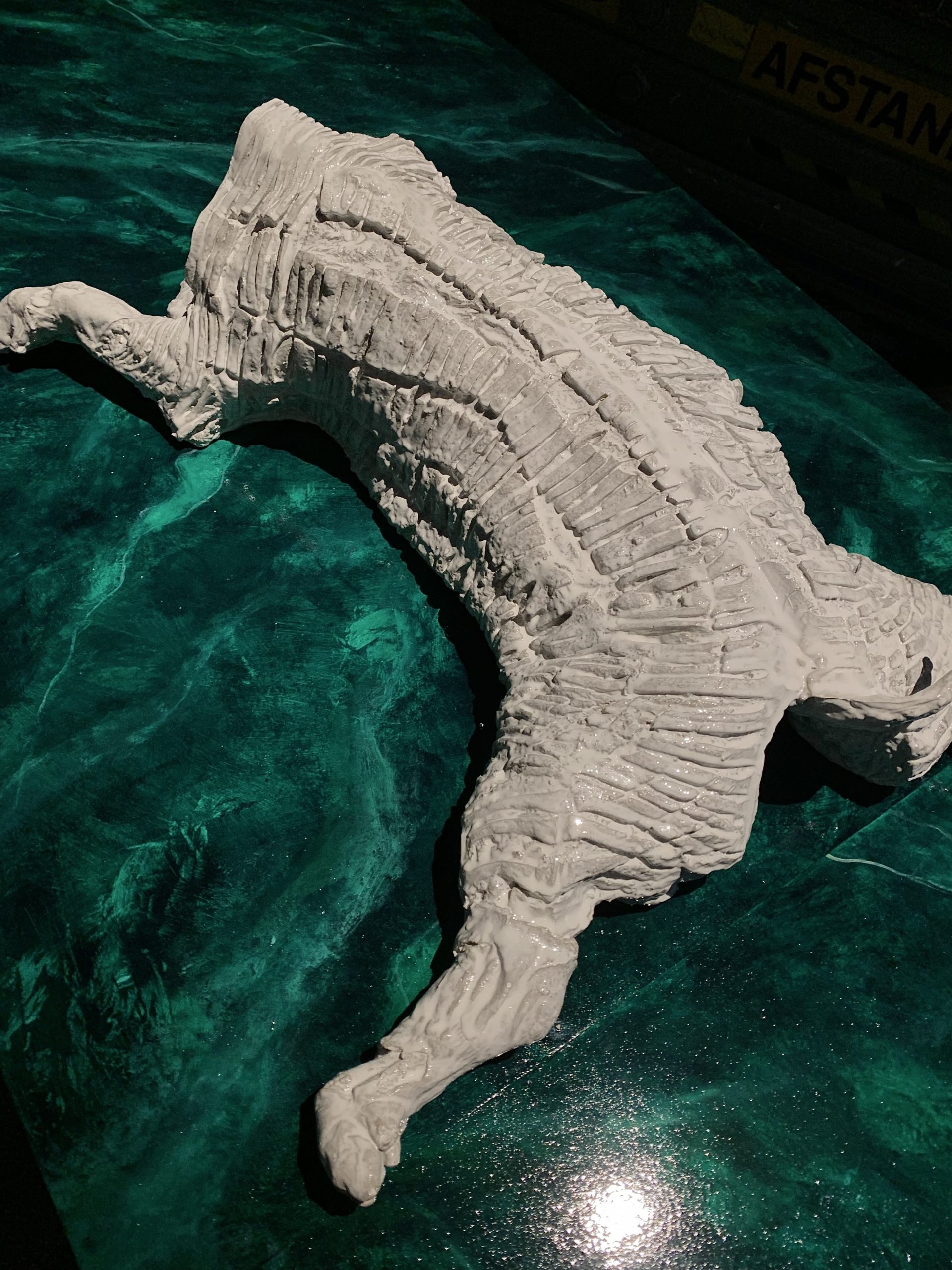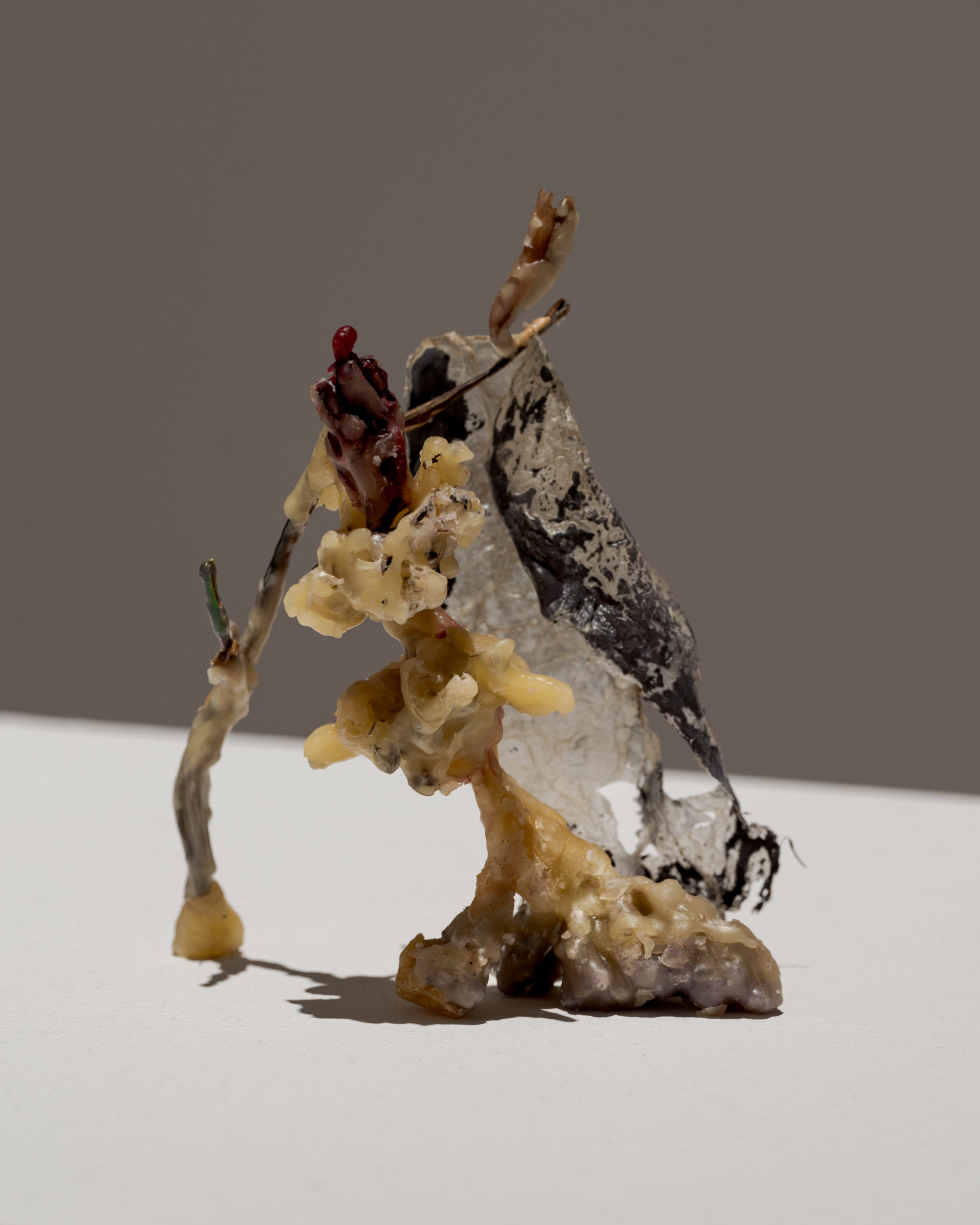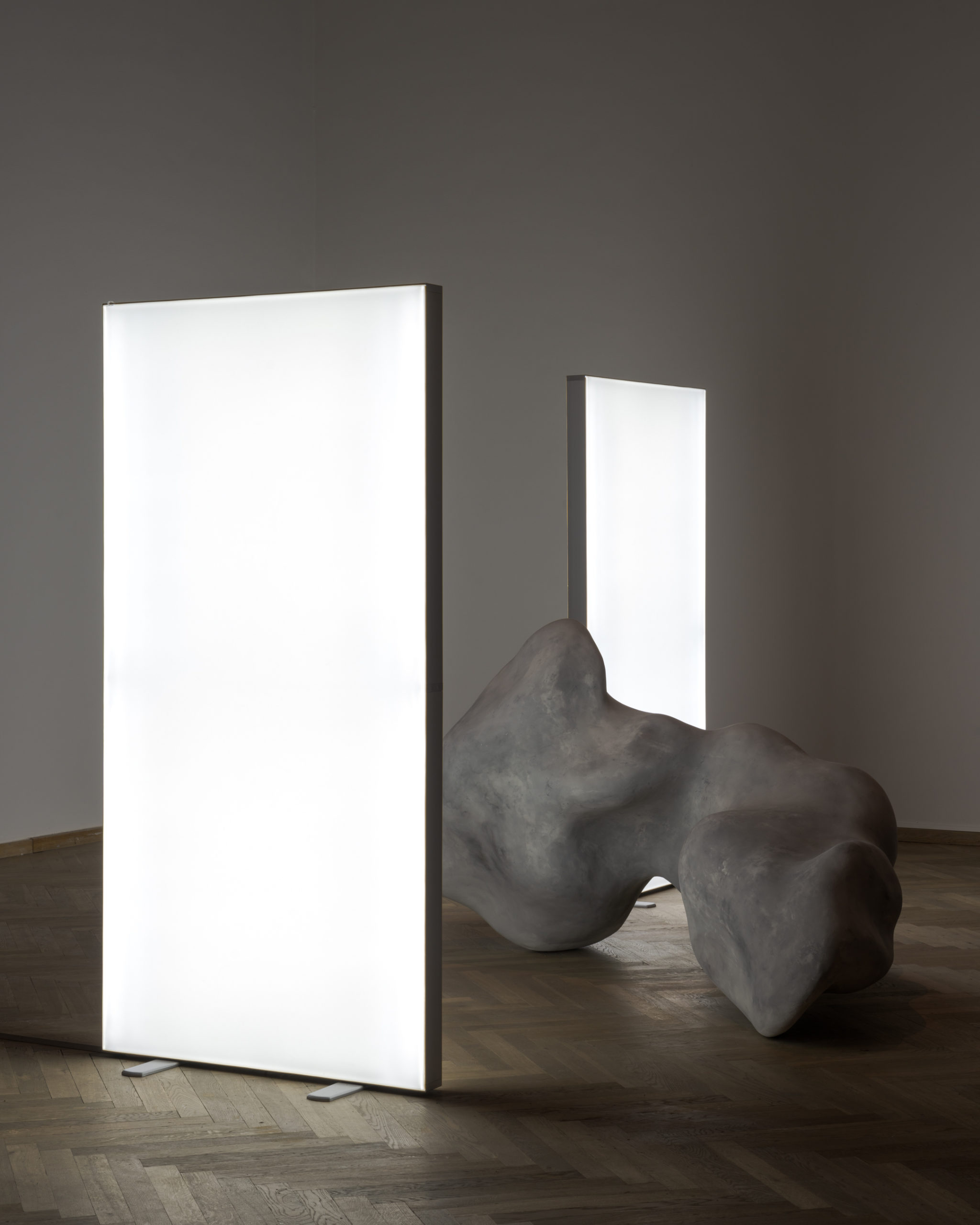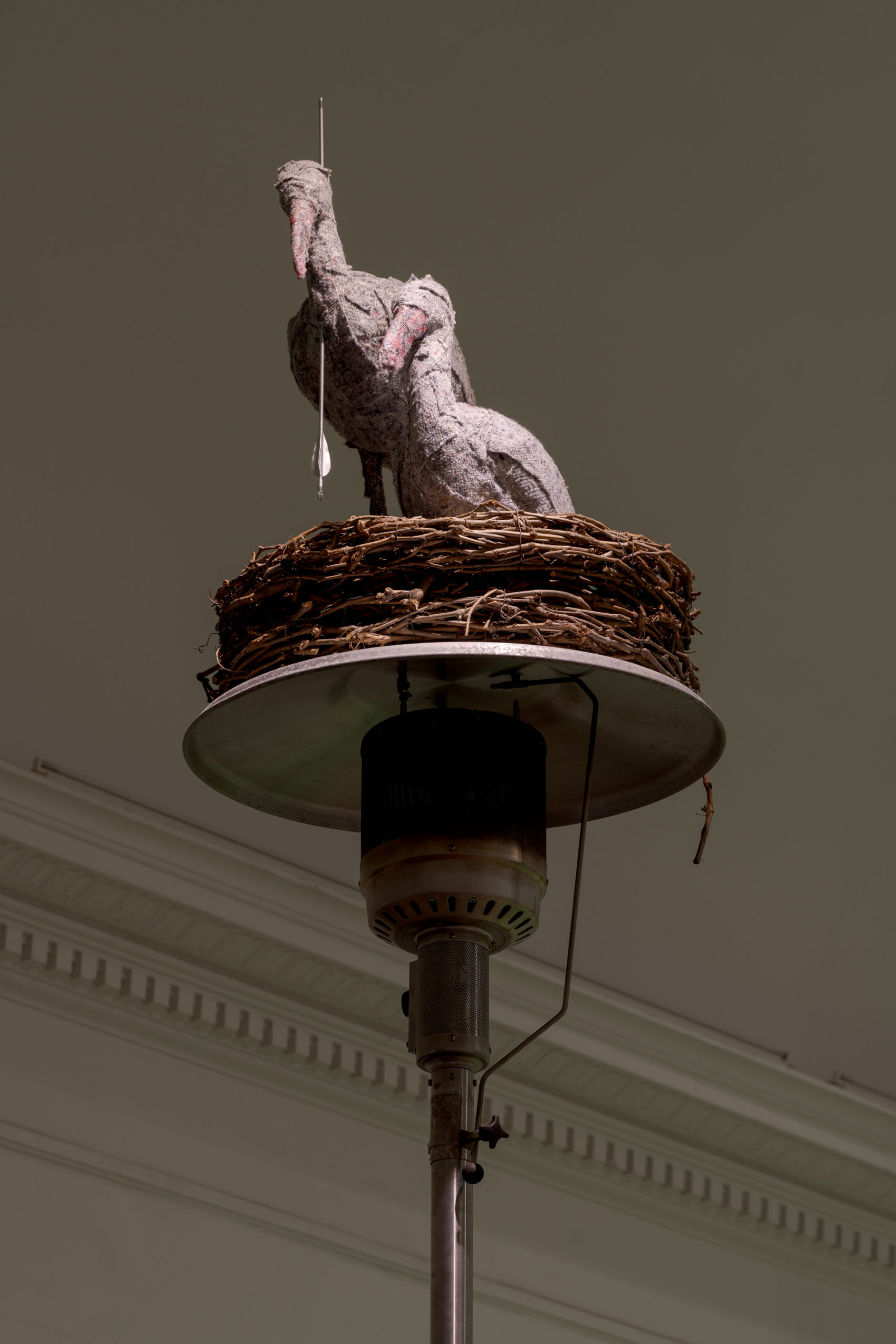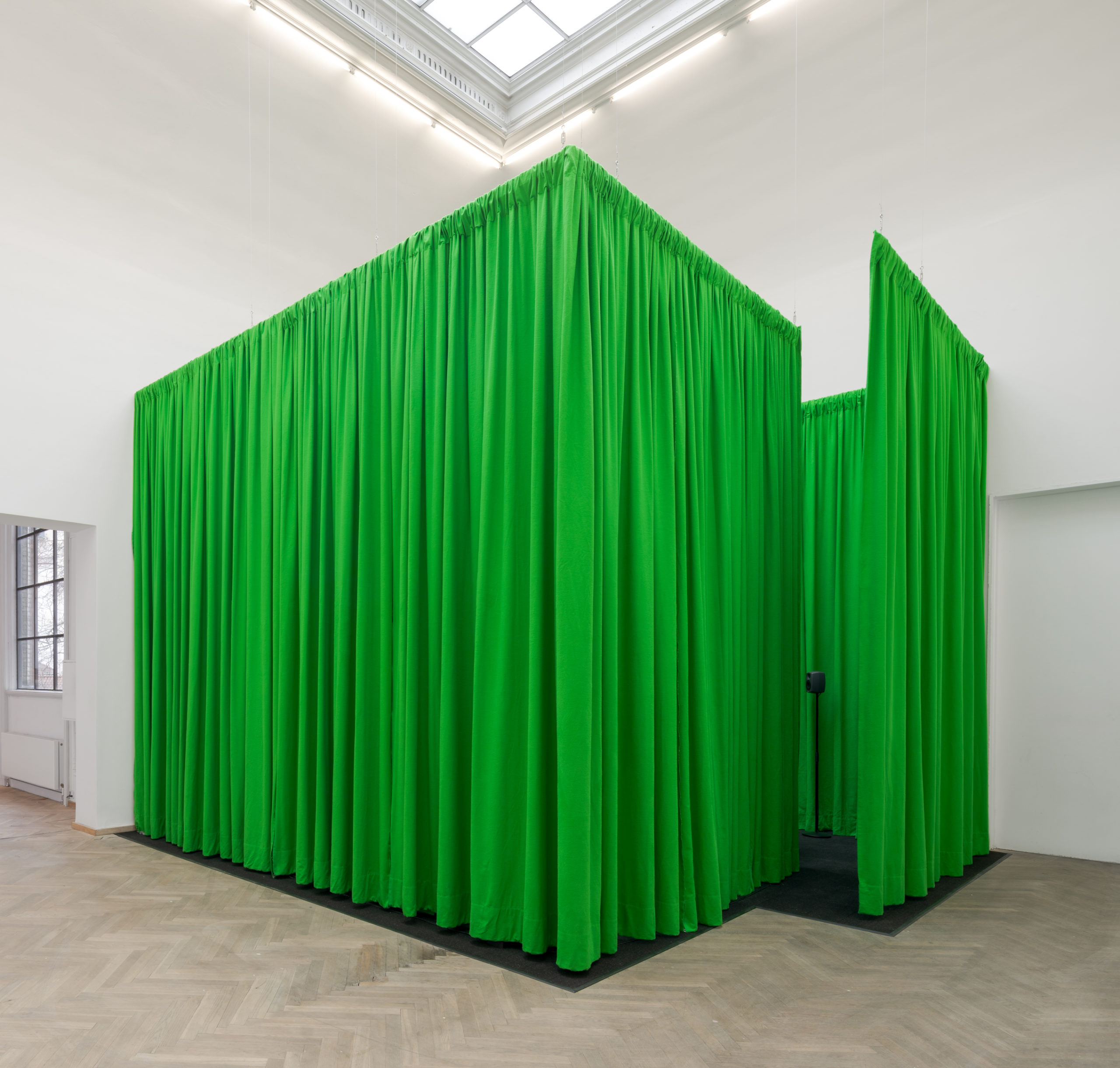Erdal Bilici
The School of Sculpture - Billedhuggerskolen
erdalbilici@gmail.com
The School of Sculpture Billedhuggerskolen erdalbilici.comHeavy Metal (2024)
Photographic prints, machined and welded steel, silver, glass charm, strobe lights, car battery
Erdal Bilici’s practice investigates how logics of the image permeates our mundane reality, and how perceptual technologies mediate our understandings of place, property, history, nature, and biography. His videos, installations, photographs, sculptures, texts, and sounds often combine cinematic and photographic tropes, computer generated imagery, and objects and signs from daily life, elaborating how representation is always tied to desire and idealization, and thus to notions of control, but also to connection.
Transformation, memory, and the passage of time are central concerns in Bilici’s sculpture titled Heavy Metal. The hanging contraption is constructed as a dialectic, binding two rectangular metal armatures with ratchet belts to produce a bilateral viewing device. Each structure hosts a photograph in a custom-made metal frame that resembles a repeating passe partout, a stepped pyramid, or the expanding accordion-like bellows of a large format camera. On one side of the sculpture, a childhood photo of the artist, his only image from that time, which was taken while he was sick from metal poisoning. On the other side, a computer-generated image, an abstraction of a self-portrait within a chromium landscape that wears a small “nazar” amulet, which in Turkish and Kurdish traditions is worn to ward off the “evil eye”, a malevolent glare causing misfortune.
These images only appear as momentary glimpses when a synchronous strobe flashes every ten seconds, powered by a car battery hanging at the heart of the contraption. Reminiscent of proto-cinematic technologies such as the “peep show”, the display device functions like a reversed camera, affirming the affective quality of cinema and photography, and emphasizing the flashes of the image and of memory.
Indeed, this ‘time machine’ imposes a flickering temporality on perception, and establishes a bridge that connects the past and the present, functioning both as a poetic reflection on technological changes in representation and on the artist’s own rite of passage on occasion of the Afgang 2024 exhibition. Bilici’s enclosed system is a mechanized yet mystic space, a channel for viewing and of being viewed, a source of power, transformation, meaning, and superstition marking the artist’s individual journey from one point to the next.
Heavy Metal, 2024
Fotografiske tryk, bearbejdet og svejset stål, sølv, glasamulet, stroboskoplys, bilbatteri
Erdal Bilicis praksis undersøger, hvordan billedlogikker gennemsyrer vores dagligdag, og hvordan perceptuelle teknologier påvirker vores forståelse af begerber som stedslighed, ejerskab, historie, natur og biografiske forhold. Hans videoer, installationer, fotografier, skulpturer, tekster og lydværker kombinerer ofte greb fra filmens og fotografiets verden, computergenererede billeder samt hverdagens genstande og tegn fra hverdagen. Herved undersøges repræsentationsaktens ofte fremhævede konnotationer til begær og idealisering, men også det paradoksale skel mellem forestillingen om kontrol og ønsket om en oprigtig følelse af forbindelse.
Transformation, hukommelse og tidslighed er centrale tematikker i Bilicis skulptur, der har fået titlen Heavy Metal. Det hængende arrangement er dialektisk opstillet, hvor to rektangulære metalarmaturer er bundet sammen med spænderemme for at skabe en todelt ‘visningsanordning’. Hver struktur rummer et fotografi i en specialfremstillet metalramme, der kan minde om en gentagen passepartout, en trinformet pyramide eller den harmonika-lignende foldebælg på et stort kamera. På skulpturens ene side ses det eneste billede af Bilici som et-årig, på et tidspunkt hvor han var syg af metalforgiftning. På den anden side ses et computerskabt billede: et abstrakt selvportræt i et kromlandskab. Figuren bærer en lille nazar-amulet, der i den tyrkiske og kurdiske kultur traditionelt bæres for at afværge det ‘onde øje’, et blik der menes at bringe uheld. De to billeder ses kun som kortevarige glimt, når et stroboskoplys blinker hvert tiende sekund. Lyset er drevet af et bilbatteri, der hænger i hjertet af genstanden. Selve anordningen kan minde om de tidlige teknologier, der gik forud for filmmediet; heriblandt de voyeuristiske peepshows, der var populære i slutningen af 1800-tallet. Vi står over for et omvendt kamera, der genbekræfter film- og fotografimediets affektive natur, idet det lægger vægt på glimtvise billeder og erindringer.
‘Tidsmaskinen’ pålægger vores sanseapparat en flimrende temporalitet, og bygger bro mellem fortid og nutid. Værket tematiserer både en poetisk refleksion over vores afbildingsformers teknologihistorie og kunstnerens egen overgangsrite i forbindelse med afgangsudstillingen. Bilicis lukkede system er et mekaniseret, og mystisk rum, hvor vi simultant ser og ses; en vej ind i kraft, transformation, betydning og overtro, der markerer kunstnerens rejse fra det ene punkt til det næste.
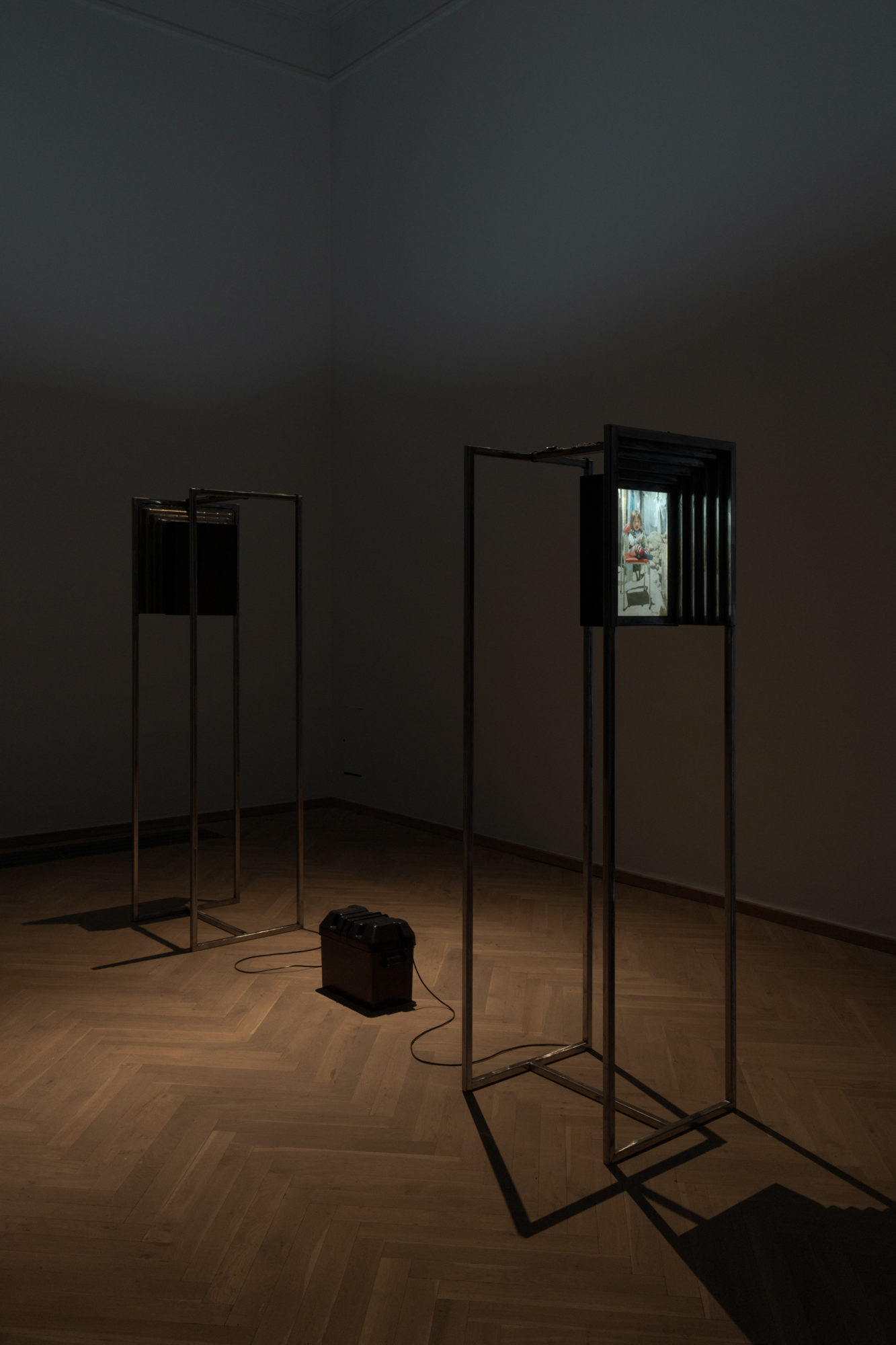
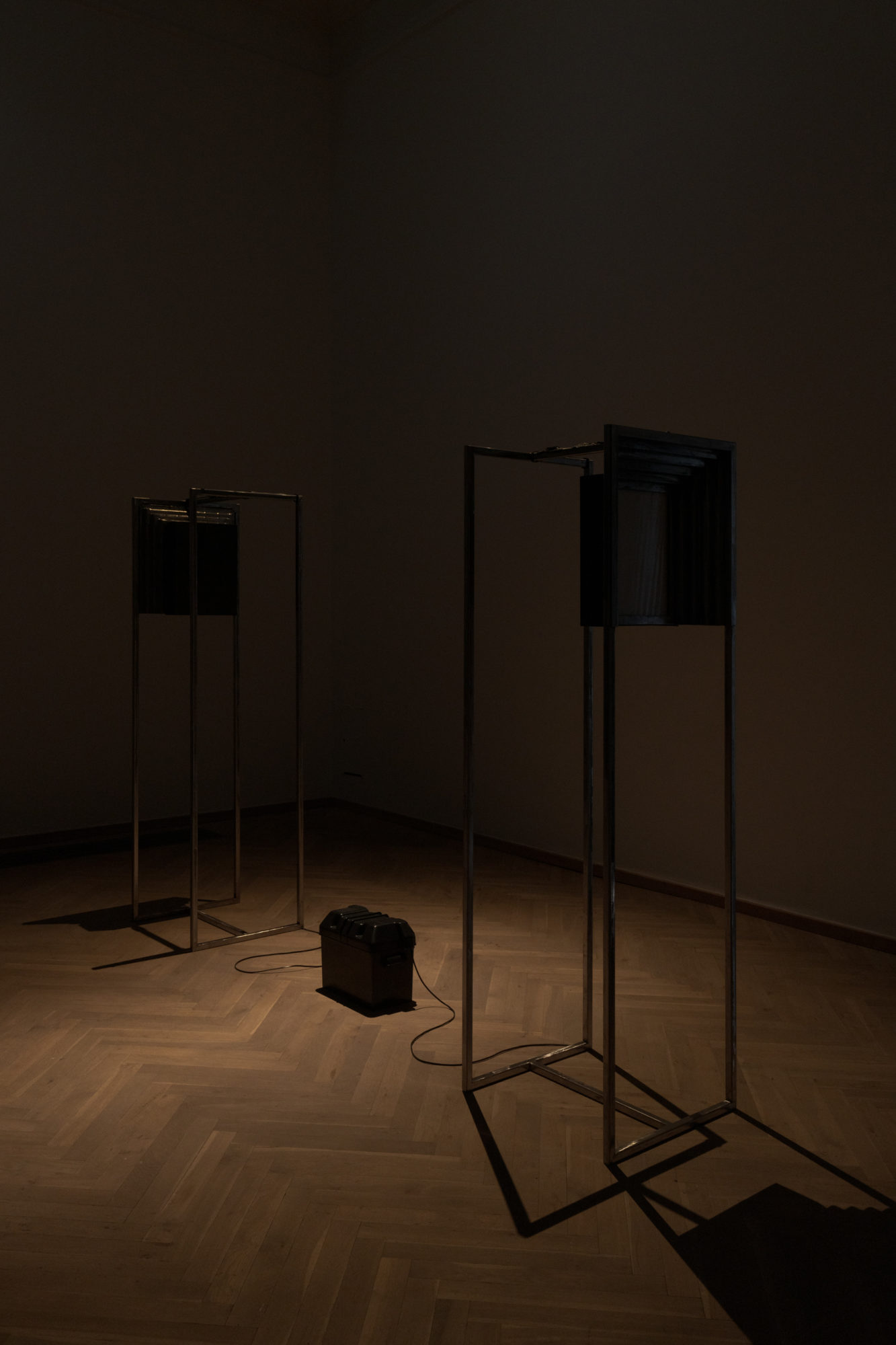
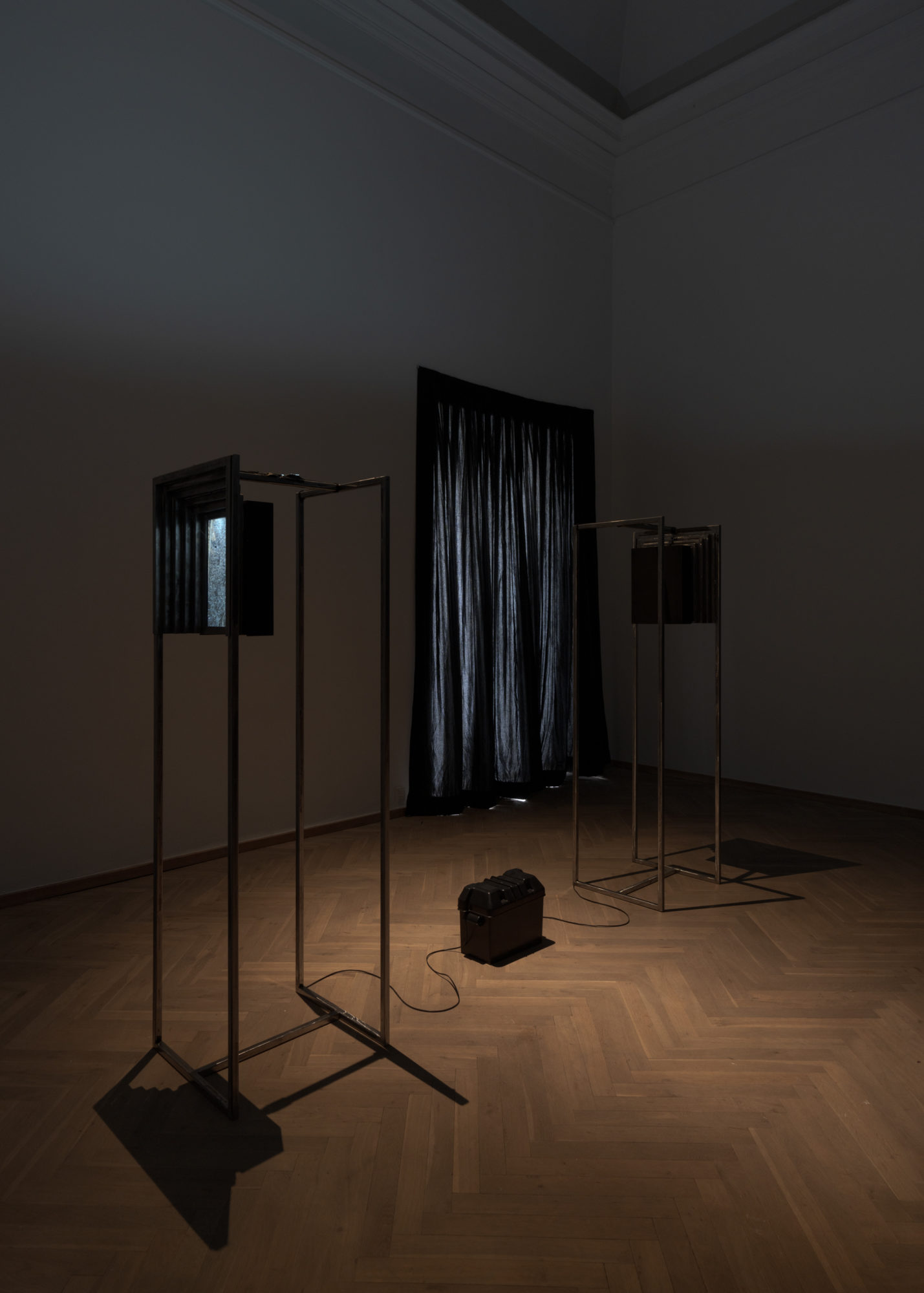
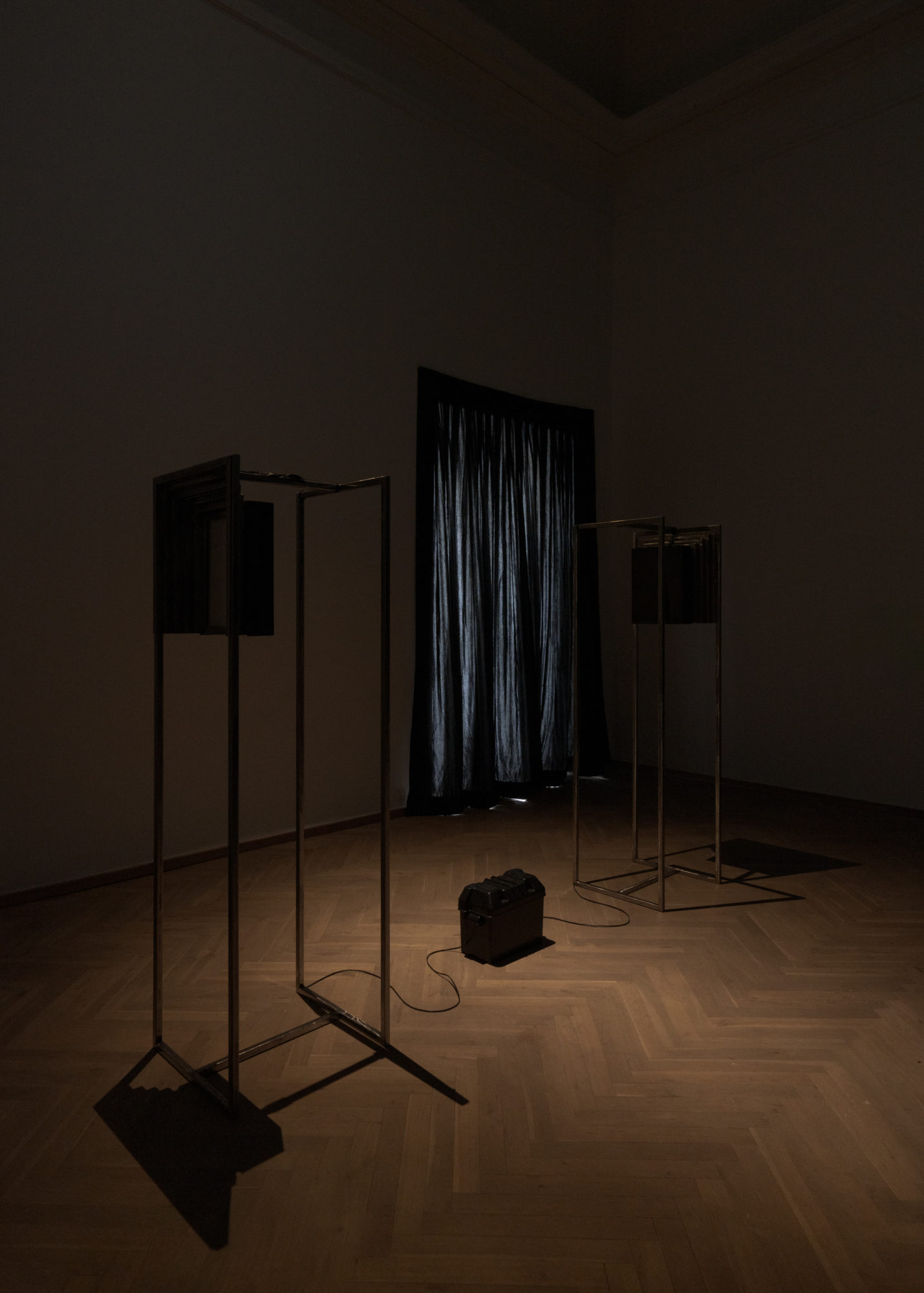
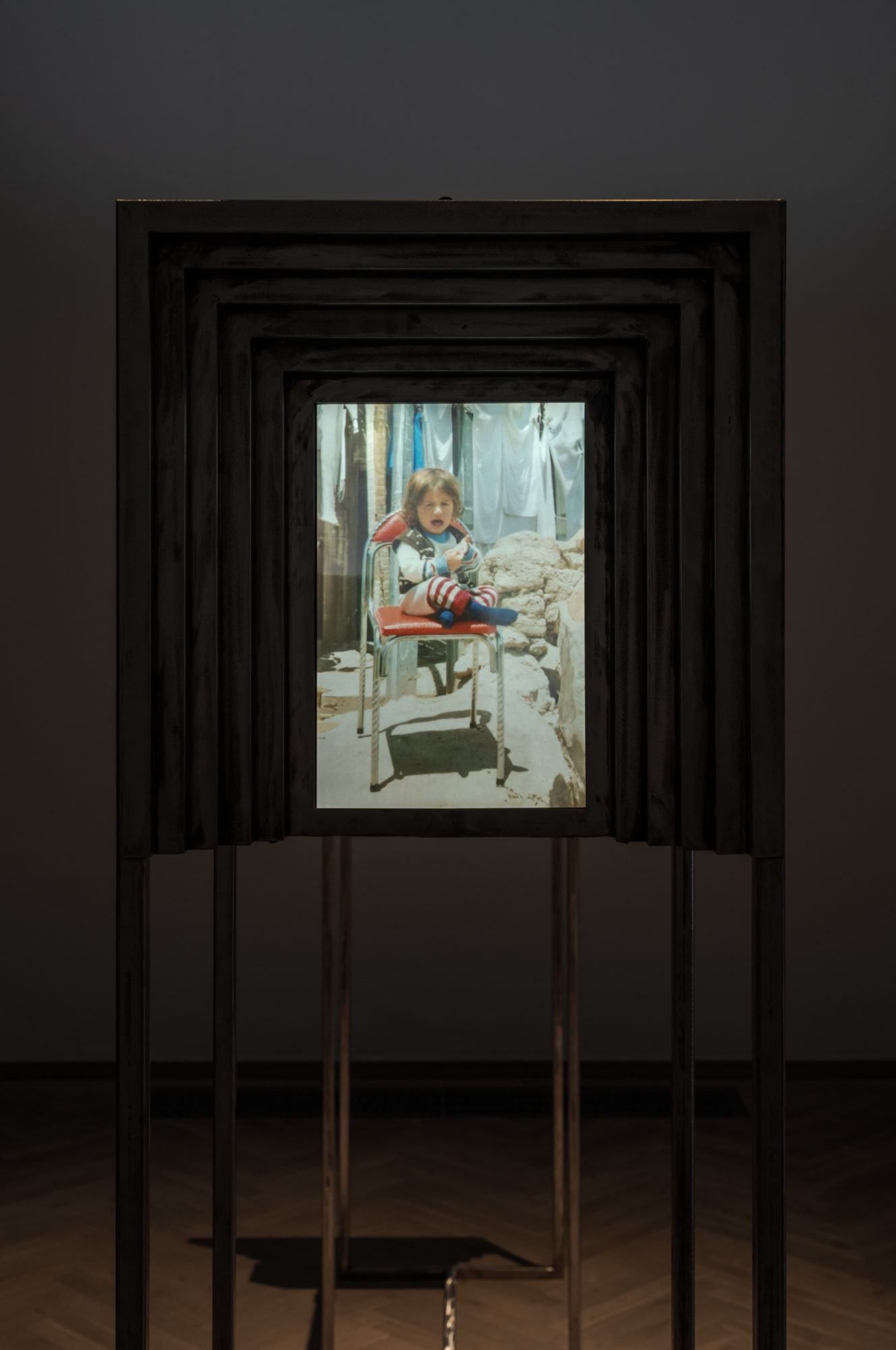
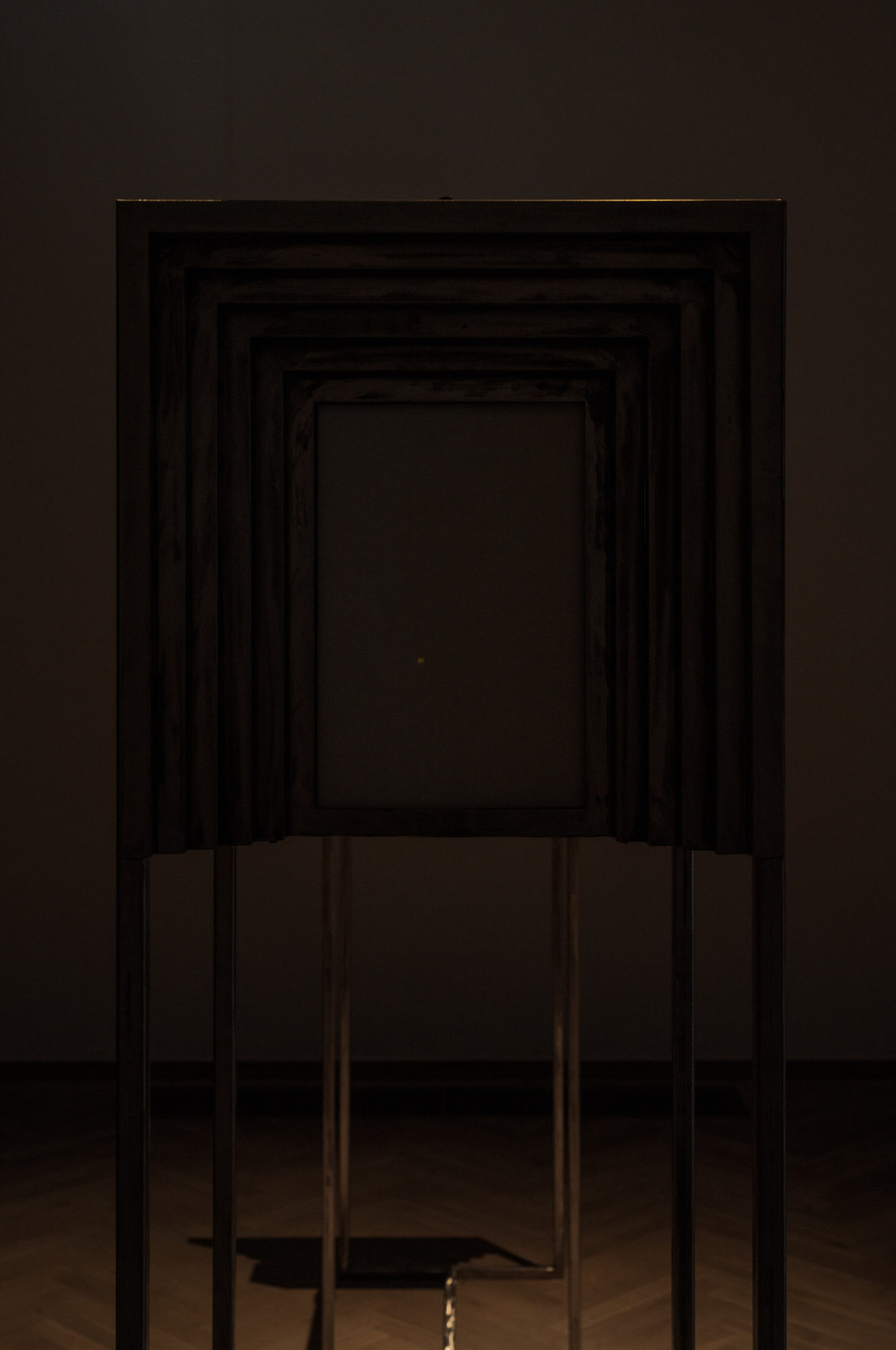
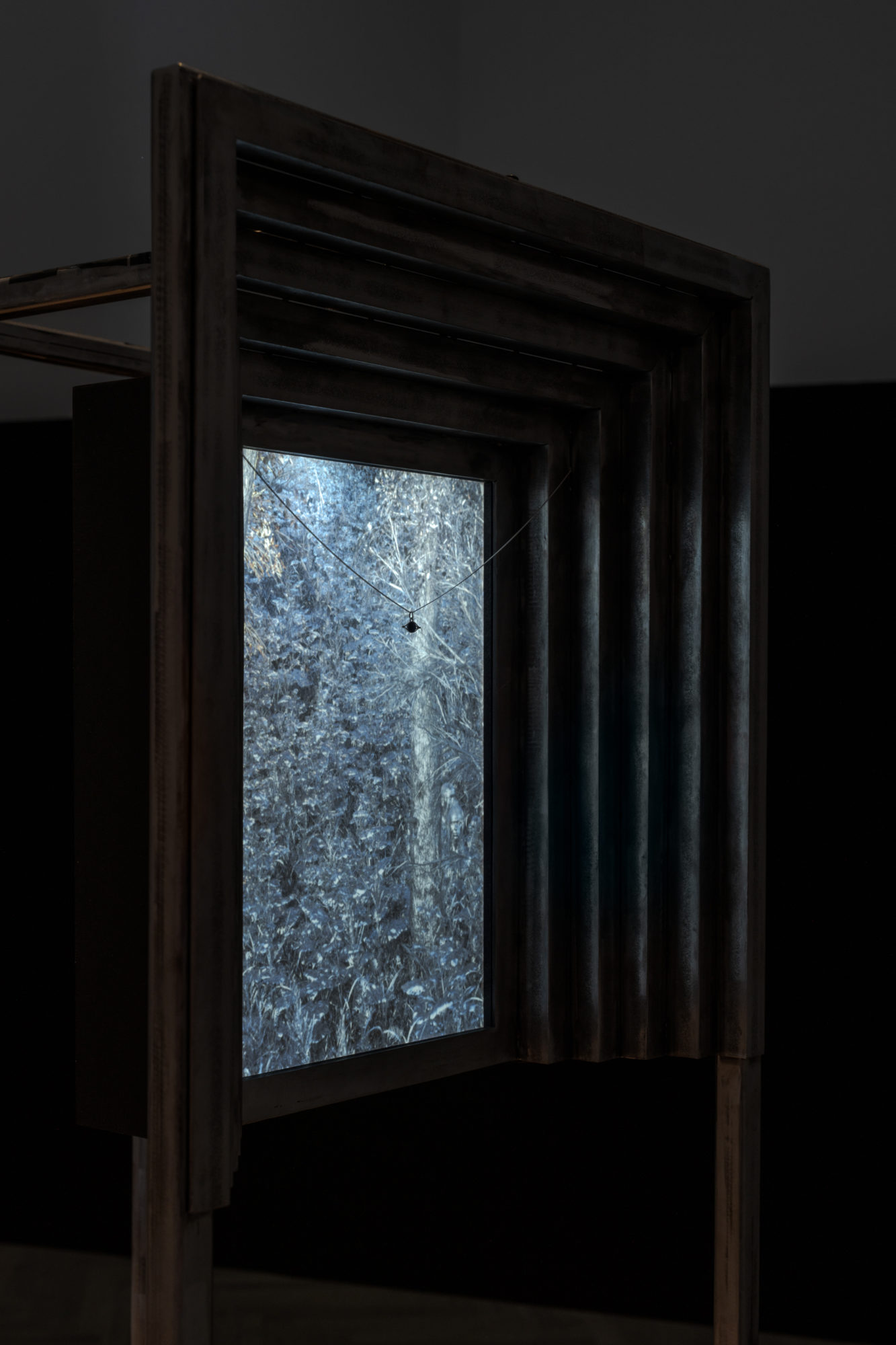
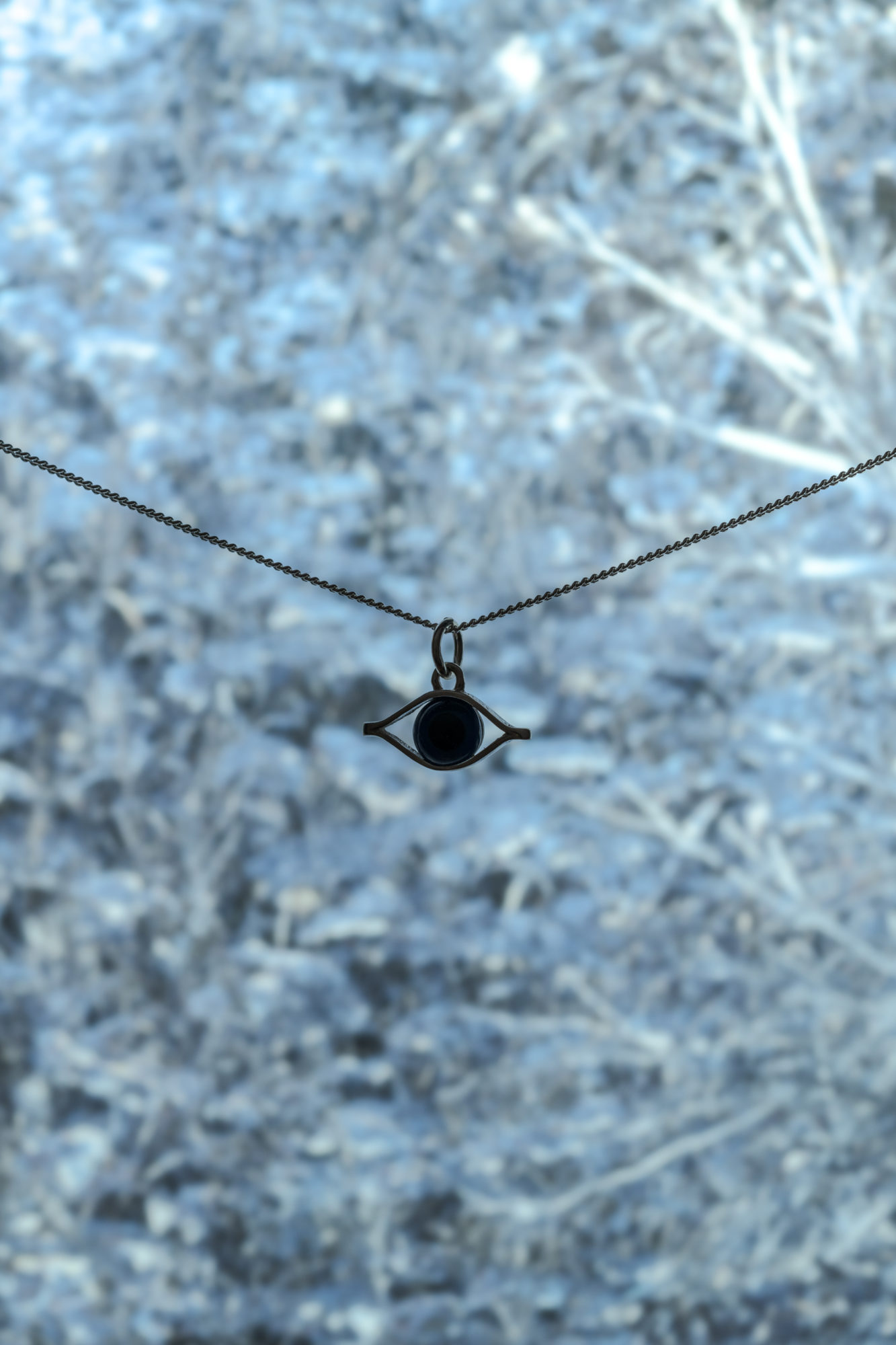
Heavy Metal (2024)
Photographic prints, machined and welded steel, silver, glass charm, strobe lights, car battery
Erdal Bilici’s practice investigates how logics of the image permeates our mundane reality, and how perceptual technologies mediate our understandings of place, property, history, nature, and biography. His videos, installations, photographs, sculptures, texts, and sounds often combine cinematic and photographic tropes, computer generated imagery, and objects and signs from daily life, elaborating how representation is always tied to desire and idealization, and thus to notions of control, but also to connection.
Transformation, memory, and the passage of time are central concerns in Bilici’s sculpture titled Heavy Metal. The hanging contraption is constructed as a dialectic, binding two rectangular metal armatures with ratchet belts to produce a bilateral viewing device. Each structure hosts a photograph in a custom-made metal frame that resembles a repeating passe partout, a stepped pyramid, or the expanding accordion-like bellows of a large format camera. On one side of the sculpture, a childhood photo of the artist, his only image from that time, which was taken while he was sick from metal poisoning. On the other side, a computer-generated image, an abstraction of a self-portrait within a chromium landscape that wears a small “nazar” amulet, which in Turkish and Kurdish traditions is worn to ward off the “evil eye”, a malevolent glare causing misfortune.
These images only appear as momentary glimpses when a synchronous strobe flashes every ten seconds, powered by a car battery hanging at the heart of the contraption. Reminiscent of proto-cinematic technologies such as the “peep show”, the display device functions like a reversed camera, affirming the affective quality of cinema and photography, and emphasizing the flashes of the image and of memory.
Indeed, this ‘time machine’ imposes a flickering temporality on perception, and establishes a bridge that connects the past and the present, functioning both as a poetic reflection on technological changes in representation and on the artist’s own rite of passage on occasion of the Afgang 2024 exhibition. Bilici’s enclosed system is a mechanized yet mystic space, a channel for viewing and of being viewed, a source of power, transformation, meaning, and superstition marking the artist’s individual journey from one point to the next.
………………………………..
Heavy Metal, 2024
Fotografiske tryk, bearbejdet og svejset stål, sølv, glasamulet, stroboskoplys, bilbatteri
Erdal Bilicis praksis undersøger, hvordan billedlogikker gennemsyrer vores dagligdag, og hvordan perceptuelle teknologier påvirker vores forståelse af begerber som stedslighed, ejerskab, historie, natur og biografiske forhold. Hans videoer, installationer, fotografier, skulpturer, tekster og lydværker kombinerer ofte greb fra filmens og fotografiets verden, computergenererede billeder samt hverdagens genstande og tegn fra hverdagen. Herved undersøges repræsentationsaktens ofte fremhævede konnotationer til begær og idealisering, men også det paradoksale skel mellem forestillingen om kontrol og ønsket om en oprigtig følelse af forbindelse.
Transformation, hukommelse og tidslighed er centrale tematikker i Bilicis skulptur, der har fået titlen Heavy Metal. Det hængende arrangement er dialektisk opstillet, hvor to rektangulære metalarmaturer er bundet sammen med spænderemme for at skabe en todelt ‘visningsanordning’. Hver struktur rummer et fotografi i en specialfremstillet metalramme, der kan minde om en gentagen passepartout, en trinformet pyramide eller den harmonika-lignende foldebælg på et stort kamera. På skulpturens ene side ses det eneste billede af Bilici som et-årig, på et tidspunkt hvor han var syg af metalforgiftning. På den anden side ses et computerskabt billede: et abstrakt selvportræt i et kromlandskab. Figuren bærer en lille nazar-amulet, der i den tyrkiske og kurdiske kultur traditionelt bæres for at afværge det ‘onde øje’, et blik der menes at bringe uheld. De to billeder ses kun som kortevarige glimt, når et stroboskoplys blinker hvert tiende sekund. Lyset er drevet af et bilbatteri, der hænger i hjertet af genstanden. Selve anordningen kan minde om de tidlige teknologier, der gik forud for filmmediet; heriblandt de voyeuristiske peepshows, der var populære i slutningen af 1800-tallet. Vi står over for et omvendt kamera, der genbekræfter film- og fotografimediets affektive natur, idet det lægger vægt på glimtvise billeder og erindringer.
‘Tidsmaskinen’ pålægger vores sanseapparat en flimrende temporalitet, og bygger bro mellem fortid og nutid. Værket tematiserer både en poetisk refleksion over vores afbildingsformers teknologihistorie og kunstnerens egen overgangsrite i forbindelse med afgangsudstillingen. Bilicis lukkede system er et mekaniseret, og mystisk rum, hvor vi simultant ser og ses; en vej ind i kraft, transformation, betydning og overtro, der markerer kunstnerens rejse fra det ene punkt til det næste.








